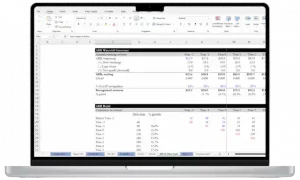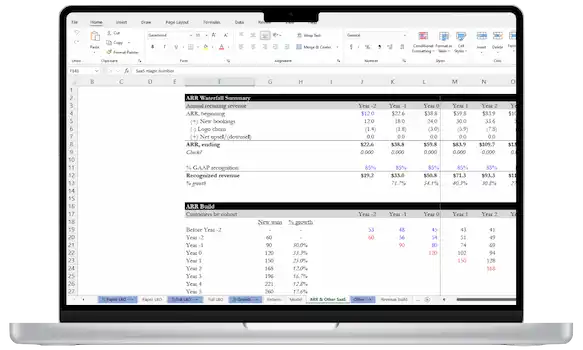The Mergers & Acquisitions (M&A) group within investment banking is highly prestigious – your deals often make it into the Wall Street Journal, and you advise high-profile clients.
And while there’s a certain glamor and excitement that comes from driving multi-million dollar fees, a career in M&A is also highly competitive and can be intense.
I’ve compiled a rundown of what to expect in the industry and how to succeed.
Let’s get started!
What is Mergers and Acquisitions (M&A) Investment Banking?
M&A investment banking groups advise corporate clients on the sale and purchase of other companies. M&A advisors can give clients advice on areas like valuation, pricing, financing to complete a deal, which sellers/buyers to reach out to, etc.
There are two sides to the transaction – the buy-side and the sell-side – and M&A advisors can advise clients on either side.
One is the buy-side, working with companies to decide what companies to acquire that would bring the highest return or strategic value.
The other is the sell-side, assisting the current owner of a company in getting the best price for their company when selling it.
Buy-Side or Sell-Side: Which is Better?
Your role as an M&A advisor changes significantly depending on which side of the deal you represent. Both require building a strong relationship with the client and excellent analytical skills.
But the way you apply those skills will vary greatly depending on whether you represent the buyer or the seller. You’ll also have a very different close rate on your deals.
In a buy-side assignment, it’s less certain that you will close a deal successfully because you are often approaching companies who may or may not be interested. Whereas in a sell-side assignment, you are almost certain to close a deal, but it’s not certain at what price bidders will agree to pay.
Both buy-side and sell-side work can be very exciting and unpredictable; however, on average, sell-side work tends to be the most predictable. That’s because the sell-side company drives the schedule and timeline of the process, which as an advisor means it’s somewhat more predictable from a work-life balance perspective.
Some say that sell-side M&A deals are the most fun. This is because you’ll close many more deals as a seller, and your work is much more defined as you position the sale.
But if you’re interested in getting into private equity or corporate development, you might enjoy the buy-side more. And when PE recruiting is taking off, you’ll have a lot lower pressure to have several closed deals under your belt when you start.
What is the Difference Between M&A and Investment Banking?
Investment banks offer several products and services to their corporate clients (e.g. debt offerings, equity offerings, IPOs, etc.). Advice on mergers and acquisitions (M&A) is one of these services provided by investment banking firms.
Further, large investment banks are typically comprised of several sub-groups (e.g. Leveraged Finance, Technology Coverage Group, Financial Sponsors). M&A is another popular sub-group within an investment bank.
M&A is a “product” group that specializes in helping clients from all industries with potential mergers & acquisition deals.
Sample Merger Process & Timeline
So what does the M&A deal process look like?
It depends on your position (analysts or associates have very different jobs than senior bankers) and the side you represent.
We’ll walk through a typical example of a merger on both the buy and sell side.
Buy-side of a Merger:
Your timeline will look different depending on whether it’s a targeted or broad process. In a targeted buy, your client has a specific company they want to purchase. In a broad process, your client is interested in buying a company but isn’t sure which one it may be.
The targeted buy tends to go much faster than the broad buy. This is because a broad buy often gets stuck in the research and presentation phase as you attempt to identify what kind of investment the client is interested in.
However, both targeted and broad buys follow this simple timeline:
- Develop a target list of potential companies to acquire or merge with
If the client isn’t sure which company to buy, you’ll help them figure it out. As an M&A investment banker, you’ll scour databases, industry reports, and network your connections to compile the best of the best. You’ll also work closely with the client to align on what their goals are and what they are trying to achieve with the acquisition.
- Present potential M&A targets, explaining the impact of potential deals to your client.
Client presentations require taking complex financial modeling and communicating in a clear, stripped-down way. Your client needs to have all the facts to make the best decision– which significantly impacts your commission.
- Your client gives feedback on their choice or asks for further research.
Most common in a broad buy scenario, your client will ask for additional research and analysis. This means you’ll go back and do lots more financial modeling and revisions.
- Repeat the cycle until the client chooses to move forward.
Once your client solidifies their choice, it’s time to begin negotiations with the target company.
- Contact the Company
Draft an Indication of Intent (IOI) and send to the target company to officially begin negotiations. If the target company is accepting multiple offers, you’ll move on to one or more bidding rounds.
- Negotiate through Bidding Rounds
Multiple interested parties will go through one or more bidding rounds, using Letters of Intent (LOIs) to communicate their selling price and other incentives to position themselves as the best candidate. Proper negotiations require a lot of research, so you can create a persuasive deal without overbidding.
- Finalize the Purchase
If you are selected as the “winning” bidder, then it’s time to finalize the purchase. Oversee a meeting between your client and the seller and finalize the purchase agreement.
Sell-side of a Merger:
The sell-side also works with broad and targeted sales. Targeted sale circumstances vary, so each one will depend significantly on previous conversations between the potential buyer(s) and seller. But a broad sell works like this:
- Get to Know Your Client and Create Marketing Materials
Hold an in-depth meeting with your client to fully understand the business. Then create materials to position the company, with an Executive Summary and Confidential Information Memorandum (CIM).
- Build a Model and Valuation Proposal
You may create a detailed financial model to describe the position and value of the company. Before soliciting bids, typically you’ll informally align with the client on what the right valuation price is that they should expect when selling their company.
- Contact Potential Buyers
Senior bankers will use the marketing materials to reach out to likely buyers – these can include private equity firms or corporate acquirers, depending on the situation. As potential buyers respond to the initial marketing materials, you continue to share information, create Non-Disclosure Agreements (NDAs), and answer questions.
- Collect Bids Before the Deadline
Potential acquirers will submit Indications of Interest (IOIs), including their proposed price.
- Narrow the Bidding Pool
As the sell-side banker, you’ll help the company examine the IOIs and select a few finalists, then allow them to adjust their offer.
- Facilitate In-Person Meetings Between Buyer and Seller
The buyers and sellers will typically hold meetings in person (called “Management meetings”) to discuss the target company and the acquirer’s plans for it.
- Continue Additional Bidding Rounds
You may go through multiple bidding rounds if you have a highly competitive bidding pool. The final round of bids will include Letters of Intent (LOIs).
- Finalize the Purchase Agreement with the Final Bidder
With your help, the client ultimately selects the “winner” from the LOIs and can negotiate the final definitive agreement.
A senior banker will do much of the interpersonal and contract work, with research, financial modeling, and presentations falling to analysts and associates.

- 24 lessons
- 6+ video hours
- Expert instructor
ONLINE COURSE
Assess Business Models Like An Investor
Designed for aspiring private equity, growth, or venture investors
Is M&A a Good Career Path?
M&A would be a great choice if you’re interested in fast-paced and learning-filled investment banking work.
Because of the depth of engagement, you learn tons of financial modeling. This makes it a good place to be if you’d like to maximize your exit opportunities after investment banking and are interested in finance roles.
Beyond that, it’s a fulfilling career, with a hands-on view of how companies and corporate boardrooms make strategic decisions. It also develops deep, versatile experience to allow you to transition to a number of other careers whenever you want.
The one challenge with M&A for long-term careers is that because it’s fast-paced, it can lead to burnout as the lifestyle is sometimes hard to keep up over many years. However, it’s great to have a stint in M&A, especially as a young banker.
Go here for more discussion of the investment banking career path in general.
Is it Hard to Get into M&A?
Becoming an investment banker is competitive for any team, and M&A is among the most competitive within investment banking.
So why is it such a popular option?
- You get to learn many aspects of corporate finance in great detail – e.g. financial modeling, LBOs, merger modeling, etc.
- You have many exit options for further career development – discussed in greater detail later
- You get to enjoy a high level of prestige and respect within the bank, given the historical role of M&A as a premier group in investment banking
“Why M&A?” Interview Question
If you’re in an investment banking interview for M&A, what characteristics might make you a good match for a career in M&A?
- You love investing.
- You love to learn about finance and different industries.
- You like to work at a fast pace at high stakes.
These are just some of the themes to pull on in your answer.
Honestly, M&A kind of sells itself, so most of the time you don’t have to convince them why M&A is great. They already know. Instead, they just want to make sure you know what you’re getting into. You can also pull on similar threads as your “Why Investment Banking?” answer.
M&A Investment Banking Salary & Hours
On average, hours tend to be somewhat more intense in M&A than hours for investment banking in general.
Work-life balance is a hard one for M&A bankers. Since deal processes move very quickly, you’ll work at 100% capacity throughout the deal.
When the deal changes suddenly, you may have to be on the phone or logged in to work for hours with little or no notice.
The demanding pace of investment banking is typically why people quit or don’t try in the first place. It can be challenging to find a sustainable balance– but for those with a temperament or lifestyle that can handle it, the payout can be massive.
Compensation is great in investment banking, and that’s no different for M&A. Analysts and associates at larger firms can expect six figures or close to it.
M&A Investment Banking Exit Opportunities
Before you put investment banking on the back burner because of the challenging hours, remember that a stint in M&A can open a lot of doors to more sustainable and equally exciting opportunities.
Many M&A investment bankers transition to careers in:
- Private Equity (PE): Experience in bulge brackets or elite boutique banks will go a long way to make it into private equity, where most firms invest in leveraged buyouts.
- Growth Equity (GE): The investments in the middle ground between venture capital and private equity realms.
- Corporate Development: An excellent option for bankers with boutique investment bank experience.
- Hedge Funds (HF): Like PE, you’ll need experience in bulge brackets or elite boutique banks to successfully manage hedge funds.
- Venture Capital (VC): Raise money to invest in startups for a high return.
- Entrepreneurship: Leverage your finance knowledge into your own asset by building your own company.
The deep financial experience you gain in M&A prepares you for many other types of investing and other paths.
Want to Learn More?
Investment banking has a massive impact on the way global business evolves. But, of course, it’s also an ever-evolving field itself!
Check out my guide on the investment banking industry (and careers within it) here.


 Break Into Growth Equity
Break Into Growth Equity

